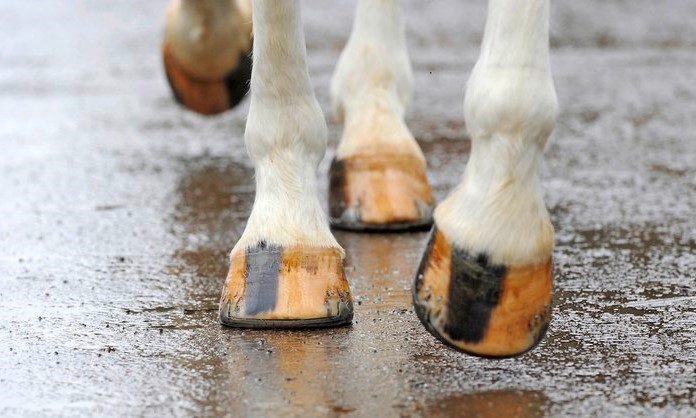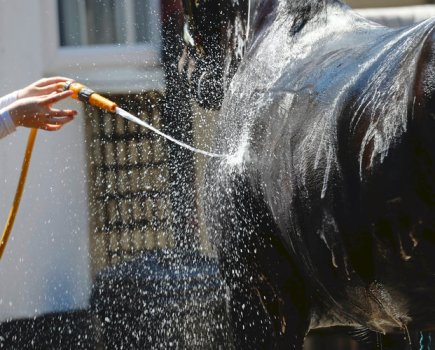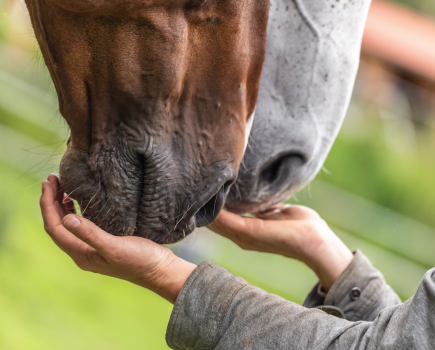Cracked hooves — when you literally see a crack start to form on the outside of a hoof — are a problem, not least because when horse hooves start to crack, it can be tricky to get them back into good condition.
Cracks can also lead to infection, triggering lameness and further hoof-related problems that will take time (and money) to sort out.
Routine hoof trimming — especially if your horse is barefoot — and being shod at regular intervals is essential to help prevent hoof cracks occurring in the first place.
Preventing cracked hooves
As a general rule, when you look at your horse’s feet there should be a nice, constant angle.
“If a hoof splays out at the bottom, this will predispose them to cracking,” explains farrier Dale Beecham Dip WCF.
“As with everything hoof-related, the best thing you can do to protect your horse’s feet and keep them in good condition is to have them shod regularly every six to eight weeks.”
Crucially, you should also have a good relationship with your farrier.
They are the expert; they know your horse’s feet and are in the best position to offer advice.
Managing a cracked hoof
When it comes to managing cracked hooves, there are several options:
1 Look at shoe position and bars
Your farrier can position any clips on the shoe away from the cracked area to avoid weakening it further.
Bar shoes (shoes that have a closed heel rather than a traditional open one) can be used to help strengthen the hoof.
Kevlar plates and acrylics can also be used.
2 Apply the right topical products
A hoof hardener or moisturiser can help to improve the condition of a horse’s hooves.
As a rule, use a product that does the opposite to the weather.
By this, I mean use a moisturiser when it’s very dry to prevent dried out hooves and a hoof hardener when it’s wet to prevent them becoming too soft.
3. Don’t wash hooves before a shoeing
Avoid washing your horse’s feet just before the farrier comes.
In fact, you should make sure very dirty hooves are cleaned early enough that they have completely dried before your farrier arrives.
“Many owners think we want to see a clean, freshly washed foot, but if you imagine the hoof as a sponge, what will happen when you drench it with a hose?” says Dale.
“It will absorb the water and swell.
“Your farrier will do their best to get the foot level, but if we shoe a wet foot, the shape will alter as it dries, and this can lead to splits forming.”
4 Add nutritional support
A balancer or hoof supplement can help to boost hoof health.
“But bear in mind that these take four or five months to take effect, so you have to give them time to make a difference,” says Dale.
“There are no quick fixes where hooves are concerned.”
5. Identify any deficiencies in the diet
You can have your hay and pasture analysed to see if your horse is missing any nutrients that are vital to hoof health.
A balanced diet is essential to healthy hooves, as well as good all-round health of your horse.
Assessing a cracked hoof
Flared feet are the most common cause of vertical cracks, which can travel up the foot and lead to lameness.
“If the cracks run horizontally, this generally causes less of a problem,” says Dale.
“Horizontal cracks are normally the result of a previous abscess or damage to the coronet band, and will simply grow out to the point where your farrier can pare them off.”
Toe cracks
When treating hoof cracks the most important thing is to identify the cause.
Cracks in the toe are most often caused by:
- Over-long hooves causing strain in the hoof wall.
- A foot imbalance, or lack of support in the toe region from an overly set back shoe.
- An injury and subsequent scarring to the coronary band that causes a fault in the hoof wall. This will have a propensity to split and allow bacteria and fungus into the structure of the hoof.
“If it’s a very superficial crack that’s complete from coronary band to ground it’s possible this happened as a result of an old trauma to the coronary band,” says Dale.
“This may have caused a scar in the horn producing coronary corium, the result of which is a gap in horn production or an area of weakened horn.”
This type of crack will widen at the base as bacteria and fungus invade the area.
The infection at the bottom needs to be debrided of necrotic tissue and cleaned with a product that treats both bacteria and fungus.
Original Cornucrescine rubbed into the coronary band will help reduce the scar tissue, as well as increasing the rate of hoof growth.
This will, over time, reduce and eventually eliminate the fault in the hoof wall.
Structural cracks
If the crack in your horse’s hoof is of a structural nature, your farrier can open up and clean the crack before applying a plastic filler, such as Imprint Granules.
“These have the same strength and flexibility as hoof and will hold the sides of the crack firmly while allowing natural hoof movement,” explains Dale.
“This will stop the crack extending into newly produced hoof and, over the course of about a year, the crack and the plastic filler should grow out.”
Whatever the cause and effect of cracked hooves, the message is simple: keep to a regular shoeing/ trimming routine and ask your farrier for advice if you have any concerns.









